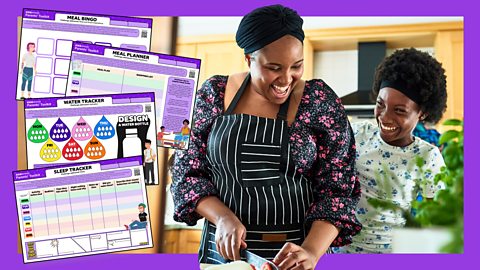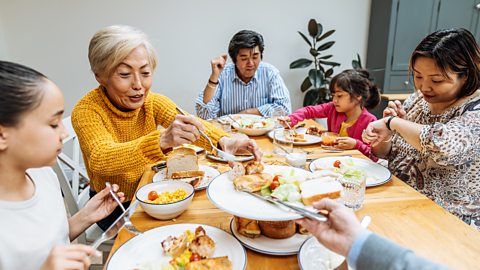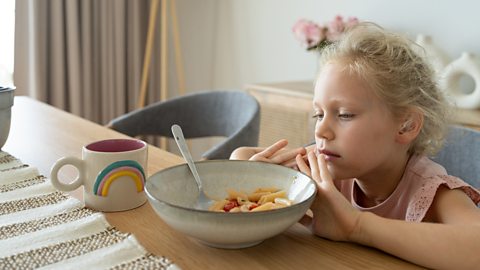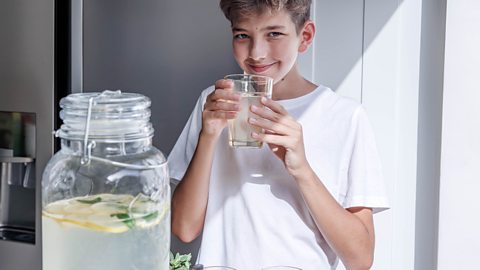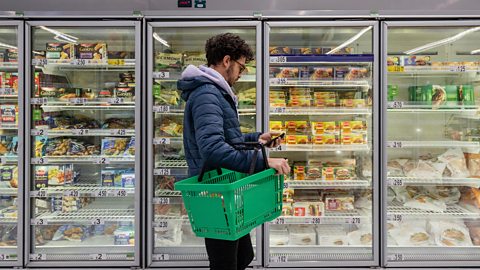Teaching children to cook is one of the best ways to develop a positive relationship with food. There are lots of ways to do this, at any age! It gives children exposure to food without having the pressure to eat it, but when they’re involved in preparation, they’re often more open to trying and eating different foods.
We know time can be tight, so we’re not suggesting you cook together every night of the week, but maybe choose a day when you know you’ve got a bit more time (and patience!) And remember, even if they're just helping you to choose the menu or cutlery it's still a form of cooking together.
Video: Families share their experiences of cooking together
Andrew: "You like doing shopping?
CJ "Yeah."
Andrew: "You're very good. You wanna go shopping tomorrow?"
CJ "Yes."
Andrew: "I feel like if she's choosing what she wants to have for dinner, for as long as it's within reason, then she's more involved with the whole cooking part. She's more, um, kind of engaged with it."
Andrew "Good."
Abi: "You're quite fussy, aren't you? Would you, would you say you are a fussy eater?"
Scarlett: "Sometimes." Abi: "Sometimes."
Abi: "We enjoyed cooking together. It's not really something that we've done particularly in the past. Um, mainly because we've got quite a small kitchen. But with, with the pack, it kind of prompted us to make a couple of things. One in particular was cookies, chocolate chip cookies. And the other thing we made was chicken nuggets. Well mix it. Maybe making those things has helped her realise that actually they're edible. Like they're okay to eat. She's watching me make it and you know, it's not as bad as you think it is. Is it?"
Danilo: "One of the main challenges you have when, when your son has autism is trying to engage him with activities. Uh, one of the, um, recommendations that we were getting is trying to, to use, um, baking together or cooking together as a way to introduce him to new foods. And I think that's one of the best learnings that we got from, from the pack. And, and we try to use it for different things. Tortilla, omelettes. It's very relaxing for him. He does everything at a very slow pace, and he gets really interested. We were getting him like a little bit closer to the, uh, to the eggs and the, and the tasting and the touching."
Priya: "Oh, watch out."Anu: "Ok Ma."
Priya: "Obviously there's a lot of risk involved. And the other thing is, I want to get things done as quick as possible. Um, and obviously involving my daughter would take much more time. But with the pack, I read about, um, cooking together will be helpful, um, for them to get involved and, um, have, develop more interest towards the food, um, like develop more interest in like, in a different texture. So I started involving her more and the benefit I see is, she gets excited about food and, uh, you know, normally, I mean before the pack I would have to tell her like, Anu finish your plate or, uh, eat your veggies. But then once she's involved in the cooking process herself, she's like, I don't, I don't even have to remind her with, um, eating her food or finishing her plate."
Andrew: "It's nice to have more time together doing things, but it also cuts, cuts down on things like watching my phone or watching your iPad."
CJ: "Yeah."
Abi: I think it's quite useful for her to know exactly what is in, you know, the food that she's eating. Um, not just getting it dished up and, and put in front of the table."Scarlett: "I'm taking away the cheese."Abi: "Um, and hopefully as she gets older as well, she, she'll be confident in the kitchen and, you know, making these recipes. And it's a life skill, isn't it? You you have to know how to, how to cook."
Danilo: "Some of the interesting things of cooking is that, I mean, if you follow recipes, then you need to follow orders, you need to follow instructions. You need to be able to uh, say it's one cup or two cups or three cups of, of things, for example. So yeah, there are like different, um, um, benefits of cooking together that, I mean, in the long term you may not realise now, but in the long term they could be useful for Daniel."
I think it’s quite useful for her to know exactly what’s in the food she’s eating, not just getting it dished up and put in front of the table. – Abi, mum of Scarlett
You could try out our Favourite Foods and Meal Planner activity together as a family, writing all your favourite foods for each family member. You can then create a meal plan for the week together by choosing at least one favourite food item for each family member to create the menu. Your child then learns the process of what it takes to enjoy a meal together, and has more input in the decisions, meaning they're more likely to appreciate and enjoy it.
What are the benefits of cooking with my child/children?
Cooking with your child offers numerous benefits, including enhancing their skills, improving their eating habits, and strengthening your bond. Here are some of the key benefits:
Physical development benefits:
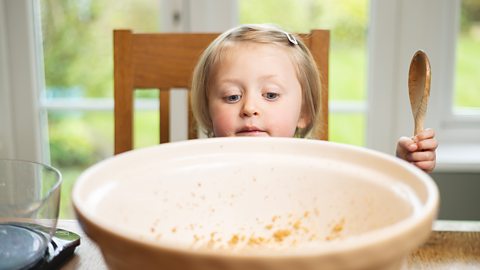
- Fine motor skills: Tasks like stirring, chopping (with supervision), and measuring, all help to develop fine motor skills in children’s hands, eyes and fingers.
- Gross motor skills: Activities such as kneading dough or mixing batter can improve gross motor co-ordination (which involve bigger muscle groups and movements) in your child’s arms and muscles.

Cognitive development benefits:
- Maths skills: Measuring ingredients and counting can reinforce maths concepts like fractions and numbers.
- Reading skills: Reading recipes and following instructions can enhance literacy skills.
- Science understanding: Cooking introduces basic science concepts, like how heat changes the state of food or the role of yeast in baking.
- Problem-solving and critical thinking: Following recipes and figuring out substitutions or adjustments can boost problem-solving and critical thinking skills.
Nutritional benefits:
- Exposure to new foods: Cooking together can encourage children to try new foods and develop a more varied intake.
- Understanding nutrition: Learning about ingredients and how meals are prepared can develop an understanding of balanced eating.
- Increased appetite: Children are often more willing to try and eat meals they helped prepare, leading to better nutritional intake.
Once she’s involved in the cooking process herself… I don’t even have to remind her [about] eating her food or finishing her plate. – Priya, mum of Anu
Social and emotional benefits:
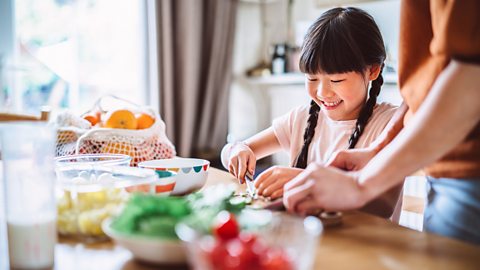
- Cooking together is a valuable life skill and provides an opportunity to spend time doing something enjoyable.
- Assigning age-appropriate tasks in the kitchen can teach children responsibility and boost their confidence and independence.
- Cooking requires following steps and waiting for food to be ready, which can help children develop patience and focus.
- Completing a recipe and creating a meal can give children a sense of achievement and boost their confidence. You can try our homemade chicken nuggets activity, which gives you and your child the opportunity to follow a recipe for a minimally-produced meal.

5 ways you can get your child engaged in cooking
- Involve your child in safe meal preparation: allow them to safely chop vegetables or measure, add and stir ingredients. If you have a toddler, take inspiration from this mealtime challenge.
- Let your child make a decision between two or three vegetables or accompaniments. This offers some choice while still staying within boundaries.
- Try preparing or cooking some of these easy family dinner recipes together. If they feel comfortable, let them taste the food that they’ve made.
- Use imagination, for example pretending to be chefs in a restaurant. You can also try a family-themed night – you choose a theme like having a picnic, eating American, Chinese, Indian or Mexican food, etc. Decorate the kitchen with flags or bunting, write a menu so each guest has one and ask your child if they want to draw a picture for each persons' menu, and encourage cooking and taking part in the whole experience together as a family.
- Create games around mealtimes. You could arrange food on the plate to create faces or shapes, give your meal an interesting name, anything that makes it fun! Use our Meal Bingo activity with your child to see if you can cook and eat the meals together and tick them off your bingo sheet as you go along.
Easy chicken nuggets recipe
- Image source, BBC
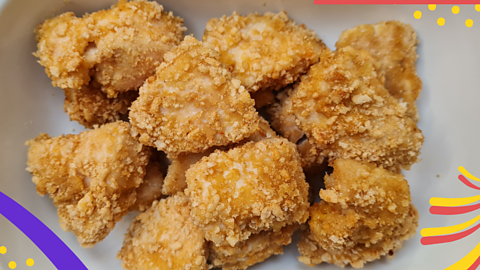
Image caption, How to make easy chicken nuggets - a kids' party recipe!
- Image source, BBC

Image caption, Ingredients needed: 580 grams of chicken, 1 egg, 55 grams of rice cereal, 2 tablespoons of olive oil.
- Image source, BBC
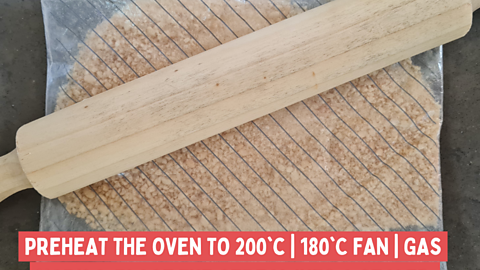
Image caption, Step one: Preheat the oven at 200'c | 180'c fan | gas mark 6. Place the cereal into a sealed bag and crush it into small pieces using a rolling pin.
- Image source, BBC
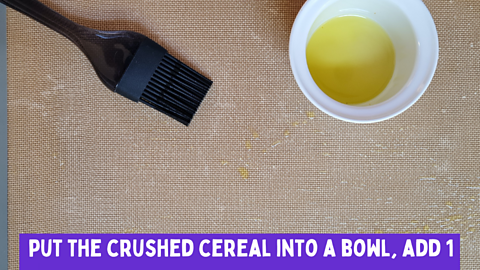
Image caption, Step two: Put the crushed cereal into a bowl, add one tablespoon of oil and mix well. Next, line and grease a large baking tray with the remaining oil.
- Image source, BBC
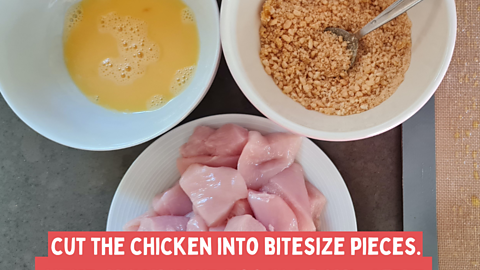
Image caption, Step three: Cut the chicken into bitesize pieces. Next, whisk your egg in a bowl. After this, dip each chicken piece in the egg followed by rolling it in the cereal.
- Image source, BBC
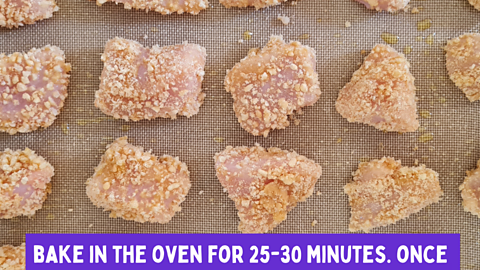
Image caption, Step four: Bake in the oven for 25-30 minutes. Once they are cooked, cut the chicken again into even smaller, more manageable piece for your child.
- Image source, BBC
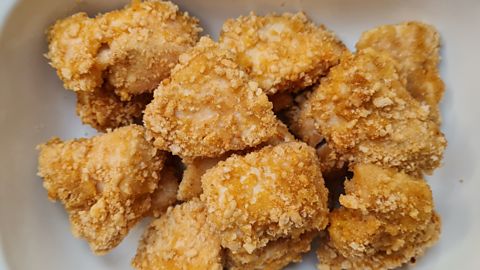
Image caption, Step five: Serve and enjoy!
1 of 7
What if my child has an allergy?
Cooking from scratch – when you have the time – can not only save you money but it also means you know exactly what’s gone into the food. This can be particularly helpful if your child has a food allergy. You’ll still need to check the list of ingredients to ensure they don’t include the allergen your child is allergic to – ingredients do change so we advise checking each time. You’ll also need to look out for the wording ‘may contain’, as this means the manufacturer can’t guarantee the product doesn’t contain that particular allergen, even though it’s not part of the listed ingredients.
For more inspiration, and depending on your child’s allergy, scroll through these nut-free recipes, egg-free recipes, dairy-free recipes or gluten-free recipes. If you have multiple food allergies, do check the ingredient list carefully and exclude or substitute as necessary.
Advice and expertise across our Happy Family Eating content was provided by children’s dietitian Angharad Banner - an independent and NHS dietitian.

Parents' Toolkit
Fun activities, real-life stories, wellbeing support and loads of helpful advice - we're here for you and your child.
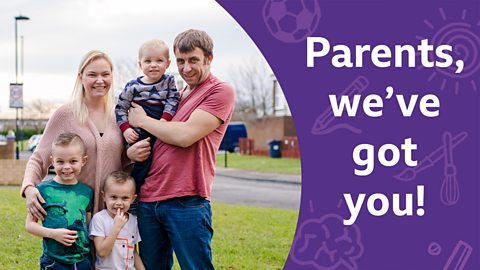
Happy Family Eating... a fun guide for parents
An overview of our detailed resources and guides to helping your child enjoy and understand their food
